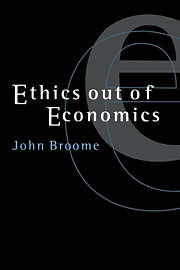Book contents
- Frontmatter
- Contents
- Preface
- 1 Introduction: ethics out of economics
- Part I Preference and value
- Part II The structure of good
- 6 Bolker–Jeffrey expected utility theory and axiomatic utilitarianism
- 7 Fairness
- 8 Is incommensurability vagueness?
- 9 Incommensurable values
- 10 Goodness is reducible to betterness: the evil of death is the value of life
- Part III The value of life
- Notes
- Bibliography
- Index
10 - Goodness is reducible to betterness: the evil of death is the value of life
Published online by Cambridge University Press: 12 November 2009
- Frontmatter
- Contents
- Preface
- 1 Introduction: ethics out of economics
- Part I Preference and value
- Part II The structure of good
- 6 Bolker–Jeffrey expected utility theory and axiomatic utilitarianism
- 7 Fairness
- 8 Is incommensurability vagueness?
- 9 Incommensurable values
- 10 Goodness is reducible to betterness: the evil of death is the value of life
- Part III The value of life
- Notes
- Bibliography
- Index
Summary
Utility theory and betterness
The methods of economics can contribute in many ways to the study of ethics. One way is that utility theory can help to analyse the structure of goodness.
At least, utility theory can help to analyse the structure of betterness, the comparative of goodness. Betterness is a mundane matter. We very commonly discuss which things are better or worse than others. We say that sun is generally better than rain; we wonder whether it would be better to move to a new job or stay in the old one; we debate about which is the best way of coping with the sufferings of refugees. Betterness and worseness are common topics of our ordinary conversation. To put it more formally, between objects from some range we may be considering, there is a betterness relation denoted by:
_ is better than _,
where each blank is to be filled in with the name of an object. Utility theory can help to analyse the structure of this relation.
What do I mean by the structure of a betterness relation? One structural feature is that a betterness relation is necessarily transitive. If A is better than B, and B is better than C, then A is necessarily better than C. I think this is a fact of logic, because for any property F, its comparative relation denoted by ‘_ is Fer than _’ is necessarily transitive. Betterness is therefore an ordering. But this is only one of its structural features. There are others, which utility theory can help to reveal.
Utility theory was originally designed as a theory of rational preferences. It consists of a number of axioms that are intended to apply to preference relations.
- Type
- Chapter
- Information
- Ethics out of Economics , pp. 162 - 174Publisher: Cambridge University PressPrint publication year: 1999
- 7
- Cited by



